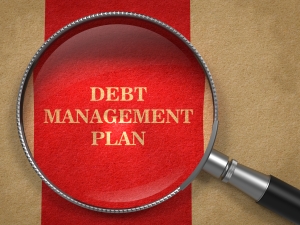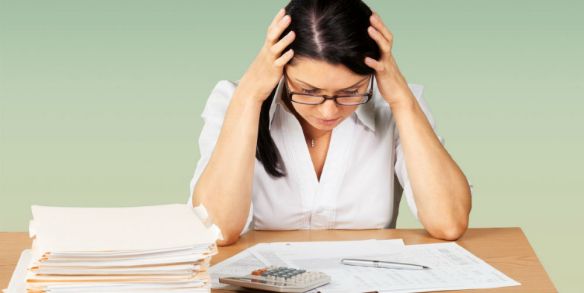
1. Commit to getting out of debt.
Getting out of debt is hard. It takes maintaining discipline over a long period of time. It demands lifestyle changes.
While you shouldn’t build a plan so strict that it would be impossible to stick to, you will have to make some tough choices. If you’re used to treating yourself to spa days or shopping sprees, you’re going to have to give up some of these tangible and expensive pleasures in order to obtain being debt-free. If you and your partner are collectively in debt, they’ll need to be on board as well. It’s not possible to do this on your own if your other half is still spending up a storm.
For motivation, create a visual reminder of what you’re working toward, such as a photo of the kind of house you’d like to buy, or the destination you plan on hitting when you can afford it. Put the image in your wallet, on your computer or wherever you spend money — to remind yourself of what you’d really like to do when you get out of debt.
2. On a spreadsheet, list all your debt, balances, interest rates and minimum payments — and find out the total of what you owe.
Knowing the total will give you a rough sense of how long this might take. If you’re shocked by the number you see, just remind yourself that this is the highest the number will be. Within the next month, it will start to get smaller. Knowing your minimum payments will help you budget, and having your interest rates will help you decide on your debt repayment strategy. List your debts in order of highest-interest rate to lowest. Tally up your minimum payments so you know the minimum amount you need to put toward your credit cards every month. Keep the list easily accessible and editable so you can refer back to it in the coming months.
3. Try to make 0% balance transfers, get your APR lowered, or refinance.
Now that you’re committed to paying down your debt, it would really help if it weren’t simultaneously increasing bit by bit. If you’re eligible for 0% balance transfers, see if it makes sense to transfer your credit card debt.
But beware the fine print. If the 0% offer only lasts six months, be sure you can pay that debt off within that timeframe. If not, you could end up paying higher interest than you were before — and it could even apply to the initial six-month period (look for the term “accrued interest” to see if this might happen). Also, calculate what the balance transfer fee is and make sure that even with the fee, you’ll still save money on the transfer.
If you’re not eligible for a 0% balance transfer or decide it doesn’t make sense for you, call your credit card company to see if you can negotiate the APR down. If your main debt is a mortgage, look into refinancing.
4. Start tracking your spending.
In order to pay down your debt, you’ll need to find ways to free up the money you already have. Knowing where your money goes will help you spot where you can cut expenses. Look for big expenses that don’t align with your priorities. If you’re surprised to see you spend $200 a month for work lunches, start packing lunch from home. Also keep an eye out for expenses that you’re not utilizing (do you actually use that monthly gym membership or Netflix subscription?). And note anything that was more expensive than it should have been, and get used to searching for coupon codes for online purchases and only shopping at in store sales.
5. Do a first pass at your budget.
Figure out your annual take home pay — what hits your bank account after taxes and 401(k) retirement contributions. If you receive a paycheck every other week, multiply the amount by 26, then divide by 12 to get the exact monthly figure. Tally up your necessary expenses: housing, transportation, utilities and groceries. Try to come up with a reasonable amount for your monthly groceries that you can stick to.
If the sum of your necessary expenses is greater than 50% of your take home pay, it might be hard for you to pay off your debt in an expedient fashion. (If you have other necessary expenses like childcare, which allows you to work, then it’s fine to go over the 50% threshold). Otherwise, if you’re exceeding the 50% mark, see if you can cut back on any of these necessary expenses in any way.
6. Work your debt and discretionary expenses into your budget.
Now, calculate what percentage of your take home pay your minimum debt payments are. If your necessary expenses are 50% or less, aim to put 20% of your take home income toward your debt. If your minimum payments are less than 20%, you’ll be able to put more than the minimum toward your debt each month.
Finally, see how much you have left to live on each month. From your monthly take home, subtract your necessary expenses and your projected 20% debt payment. Divide the leftover by 4.33 to see how much you can spend each week. Is this enough to live on each week for your dining out, shopping, gym, entertainment, travel, gifts, cable, health and other costs?
If not, get the numbers to a ballpark range that feels doable, even if it means not hitting that 20% debt repayment goal. Expect that you’ll have to go through a period of trial and error before you find the exact plan for you. But make a decision, and head into the next step knowing what you’ll be paying toward your debt every month.
7. Start your debt repayment plan.
Now that you have a monthly debt repayment target, go back to your debt spreadsheet. Pay the minimums on every debt except the highest interest rate debt. Put the rest of your debt repayment money toward that debt every month until it’s gone. Afterward, cross it off the list and do the same for what is currently the second highest interest rate debt. Continue like this down the list. This method of repayment will ensure you pay the least interest.
8. Stick to your weekly allowance.
The only way you’ll be able to pay off your debt is if you don’t keep adding to it. This means being vigilant about living within your means. Depending on your income and the cost of living in your area, this can be difficult unless you keep an eye on it. If you know you need to make a shift in your spending habits, try using cash. Take out your weekly allowance in cash each week and only let yourself spend that amount until it runs out.
9. Adapt to your new lifestyle.
Now that you’ve started on your plan, you need to learn what behaviors will support it. If you feel comfortable doing so, tell friends and family about your debt repayment goal so they understand why you’re suggesting more potlucks. If a friend suggests an activity that will be difficult on your budget, look for good free or inexpensive alternatives.
Even for non-social activities like personal hobbies, look for ways to cut costs: If you dropped the gym, can you run outside or play tennis with a friend? Maybe you realize that with advanced planning, you can more cheaply stock up on household items by buying in bulk. To freshen up your wardrobe, browse good local thrift shops or hold clothing swaps with friends.
10. Earn more money, and put gifts and windfalls toward your debt.
Finally, one of the best ways to get out of debt — is to earn more money. While cutting costs might free up a few hundred every month, a solid side gig could give you an extra $1,000 or more to put toward your debt. Do you have a hidden talent that you could put to work for you? If so, let everyone in your network know that you’re looking for freelance gigs. Put your gifts and windfalls to work as well. If you receive a large sum, put the vast majority toward your debt. With a little discipline, you really can become debt free!

 Getting out of debt is much harder than getting into it. But you can do it — and along the way, you’ll rid yourself of a lot of stress.
Getting out of debt is much harder than getting into it. But you can do it — and along the way, you’ll rid yourself of a lot of stress.
 You don’t have to be a reckless spender to find yourself in debt. CNN touts that “one in three American adults have debt in collections.”
You don’t have to be a reckless spender to find yourself in debt. CNN touts that “one in three American adults have debt in collections.”
